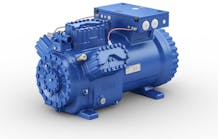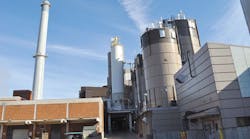Realizing the growing importance of sustainability to students and faculty and staff members, University of Missouri (MU) Chancellor Brady J. Deaton signed the American College & University Presidents’ Climate Commitment in 2009 and established a sustainability office. To help achieve sustainability goals—the current climate action plan calls for a 30-percent reduction in greenhouse-gas emissions by 2016—as well as meet future campus energy needs efficiently and reliably, MU replaced an old and increasingly unreliable coal-fired boiler with a new 100-percent-biomass-fired boiler.
The new boiler is fueled with more than 100,000 tons of regionally supplied and sustainably sourced woody biomass annually. Along with the co-firing of biomass in the plant’s stoker boilers, the new biomass boiler is expected to help reduce MU’s use of coal by more than 25 percent.
The Construction Process
On-site construction began in May 2010 and was completed in December 2012 at a cost of $75 million. The construction manager was McCarthy Building Companies Inc. of St. Louis in partnership with CB&E Constructors of Chesterfield, Mo. Sega Inc. of Overland Park, Kan., was the design engineer.
“The power-plant upgrade is a very complex and highly technical project that has presented many challenges to the team,” McCarthy Building Companies Project Director Mark Smith said as the project was nearing completion. “The work is being executed within a fully operational combined-heat-and-power facility that provides continuous utility services to the MU campus.
“... Power-plant operations, energy management, MU construction management, the design team, and our construction-management staff have, through constant daily communication and collaboration, been highly successful at achieving both of these objectives,” Smith continued. “The project will result in reduced emissions, including greenhouse gases; a 25-percent reduction in the use of fossil fuels; a significant increase in the use of locally available fuel; and expanded opportunities for the university to continue their ongoing research of alternate fuels.”
The project included expansion of the boilerhouse, restoration of two 325-ft-tall cast-in-place concrete chimneys, and replacement of the plant’s fuel-unloading, handling, and storage system.
So that the power plant could remain fully operational, temporary fuel-handling and conveying systems were put in place to feed the remaining boilers. The temporary systems provided an uninterrupted supply of fuel and, thus, steam and electrical power for approximately eight months.
Work to provide new fuel systems included construction of a new fuel-unloading and processing building, five fuel-storage silos, and conveyor systems.
The first phase of the fuel project involved replacing the coal system, which included constructing two under-silo coal conveyors that travel from the fuel-receiving building to “bucket” elevators adjacent to the boilerhouse. Each conveyor system is approximately 250 ft in length. The work also included replacement of two approximately 200-ft-long over-bunker coal conveyors in the boilerhouse and two 80-ft-tall vertical bucket elevators.
The second phase of the fuel project included construction of the biomass-fuel system, which includes three storage silos and a system of conveyors and bucket elevators that parallels the fuel system from the unloading and processing building to the boilerhouse.
Fenton, Mo.-based Kaiser Electric was the electrical contractor. With the coal-system component fast-tracked to beat winter weather, 30 electricians worked in two shifts six days a week.
“Kaiser Electric brought the manpower and resources to the project team that were required to execute an extremely difficult project in a very short period of time and keep the plant running without interruption,” Smith said.
SIDEBAR: How the New Biomass Boiler Works
• Fluidized sand at the bottom of the furnace is heated with gas start-up burners. This hot, fluidized sand ignites the biomass when it enters the furnace. Hot flue gas is created from the combustion of the biomass.
• Hot flue gas from the combusted biomass travels from the furnace area through the boiler, transferring heat to water flowing through the boiler.
• Steam from the water is captured in a drum and flows through a superheater.
• The steam leaves the boiler and goes to the plant’s steam turbine generators, which produce electricity and thermal energy for the campus.
For Design Solutions author guidelines, call Scott Arnold, executive editor, at 216-931-9980, or write to him at [email protected].











